2001 CHRYSLER VOYAGER check transmission fluid
[x] Cancel search: check transmission fluidPage 4112 of 4284
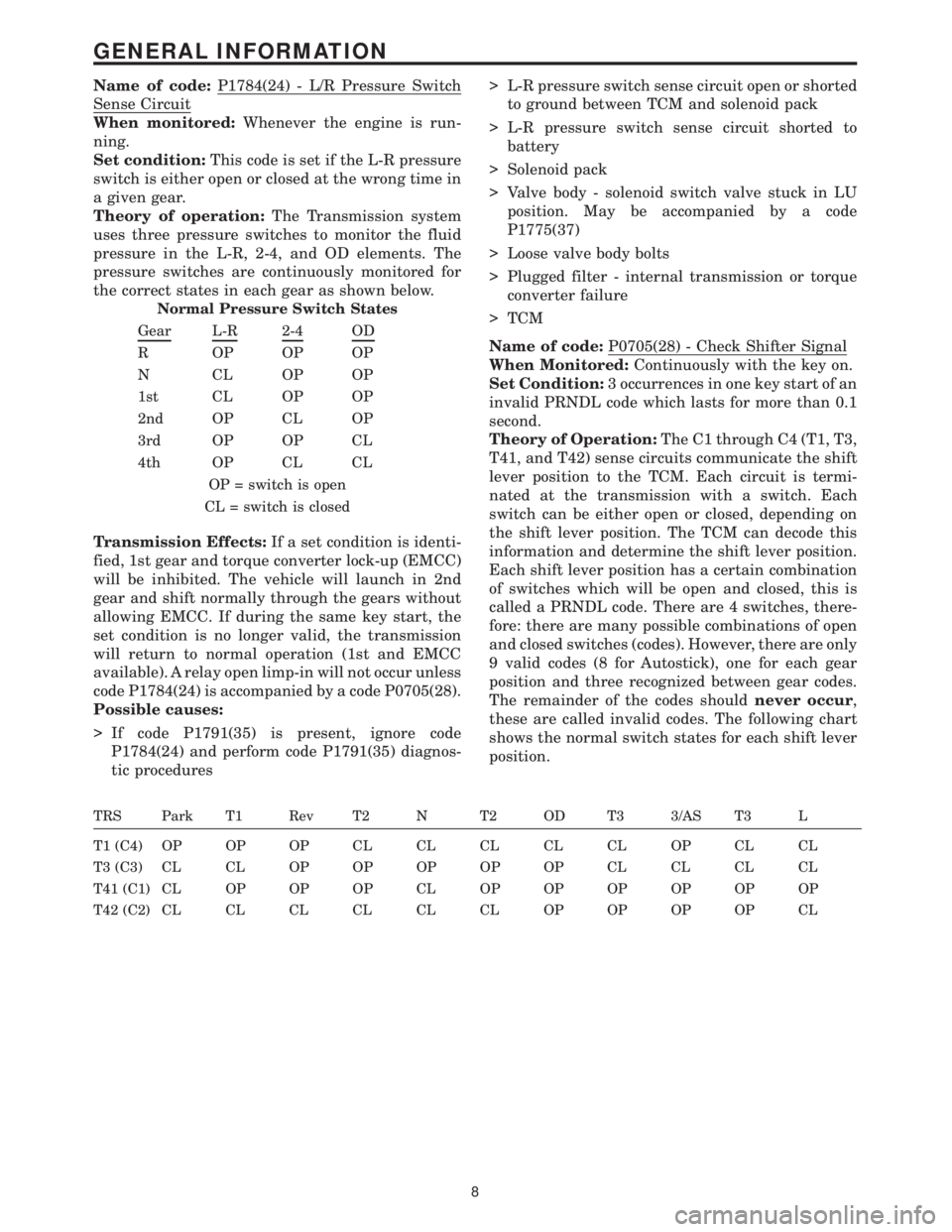
Name of code:P1784(24) - L/R Pressure Switch
Sense Circuit
When monitored:Whenever the engine is run-
ning.
Set condition:This code is set if the L-R pressure
switch is either open or closed at the wrong time in
a given gear.
Theory of operation:The Transmission system
uses three pressure switches to monitor the fluid
pressure in the L-R, 2-4, and OD elements. The
pressure switches are continuously monitored for
the correct states in each gear as shown below.
Normal Pressure Switch States
Gear
L-R2-4OD
R OPOPOP
NCLOPOP
1st CL OP OP
2nd OP CL OP
3rd OP OP CL
4th OP CL CL
OP = switch is open
CL = switch is closed
Transmission Effects:If a set condition is identi-
fied, 1st gear and torque converter lock-up (EMCC)
will be inhibited. The vehicle will launch in 2nd
gear and shift normally through the gears without
allowing EMCC. If during the same key start, the
set condition is no longer valid, the transmission
will return to normal operation (1st and EMCC
available). A relay open limp-in will not occur unless
code P1784(24) is accompanied by a code P0705(28).
Possible causes:
> If code P1791(35) is present, ignore code
P1784(24) and perform code P1791(35) diagnos-
tic procedures> L-R pressure switch sense circuit open or shorted
to ground between TCM and solenoid pack
> L-R pressure switch sense circuit shorted to
battery
> Solenoid pack
> Valve body - solenoid switch valve stuck in LU
position. May be accompanied by a code
P1775(37)
> Loose valve body bolts
> Plugged filter - internal transmission or torque
converter failure
> TCM
Name of code:P0705(28) - Check Shifter Signal
When Monitored:Continuously with the key on.
Set Condition:3 occurrences in one key start of an
invalid PRNDL code which lasts for more than 0.1
second.
Theory of Operation:The C1 through C4 (T1, T3,
T41, and T42) sense circuits communicate the shift
lever position to the TCM. Each circuit is termi-
nated at the transmission with a switch. Each
switch can be either open or closed, depending on
the shift lever position. The TCM can decode this
information and determine the shift lever position.
Each shift lever position has a certain combination
of switches which will be open and closed, this is
called a PRNDL code. There are 4 switches, there-
fore: there are many possible combinations of open
and closed switches (codes). However, there are only
9 valid codes (8 for Autostick), one for each gear
position and three recognized between gear codes.
The remainder of the codes shouldnever occur,
these are called invalid codes. The following chart
shows the normal switch states for each shift lever
position.
TRS Park T1 Rev T2 N T2 OD T3 3/AS T3 L
T1 (C4) OP OP OP CL CL CL CL CL OP CL CL
T3 (C3) CL CL OP OP OP OP OP CL CL CL CL
T41 (C1) CL OP OP OP CL OP OP OP OP OP OP
T42 (C2) CL CL CL CL CL CL OP OP OP OP CL
8
GENERAL INFORMATION
Page 4114 of 4284
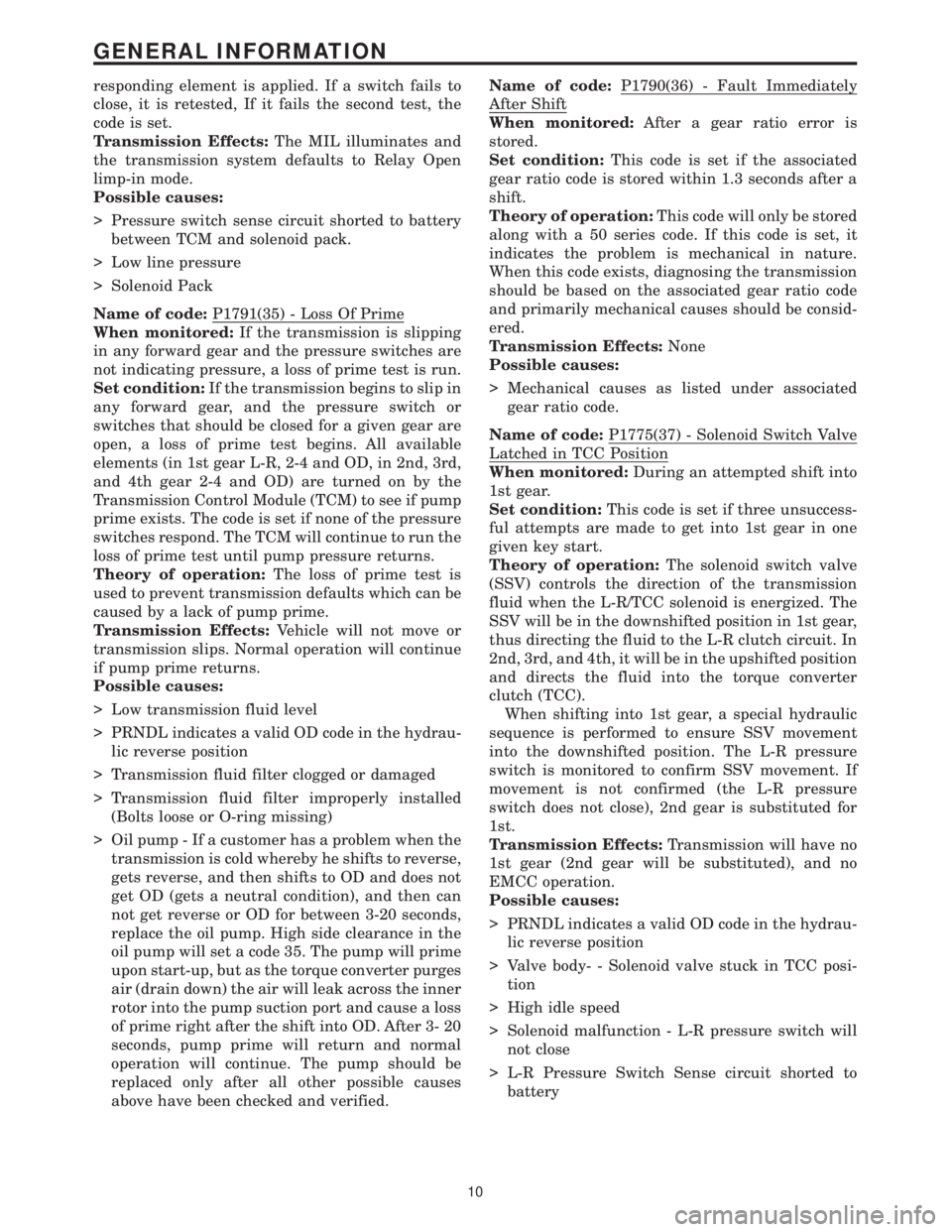
responding element is applied. If a switch fails to
close, it is retested, If it fails the second test, the
code is set.
Transmission Effects:The MIL illuminates and
the transmission system defaults to Relay Open
limp-in mode.
Possible causes:
> Pressure switch sense circuit shorted to battery
between TCM and solenoid pack.
> Low line pressure
> Solenoid Pack
Name of code:P1791(35) - Loss Of Prime
When monitored:If the transmission is slipping
in any forward gear and the pressure switches are
not indicating pressure, a loss of prime test is run.
Set condition:If the transmission begins to slip in
any forward gear, and the pressure switch or
switches that should be closed for a given gear are
open, a loss of prime test begins. All available
elements (in 1st gear L-R, 2-4 and OD, in 2nd, 3rd,
and 4th gear 2-4 and OD) are turned on by the
Transmission Control Module (TCM) to see if pump
prime exists. The code is set if none of the pressure
switches respond. The TCM will continue to run the
loss of prime test until pump pressure returns.
Theory of operation:The loss of prime test is
used to prevent transmission defaults which can be
caused by a lack of pump prime.
Transmission Effects:Vehicle will not move or
transmission slips. Normal operation will continue
if pump prime returns.
Possible causes:
> Low transmission fluid level
> PRNDL indicates a valid OD code in the hydrau-
lic reverse position
> Transmission fluid filter clogged or damaged
> Transmission fluid filter improperly installed
(Bolts loose or O-ring missing)
> Oil pump - If a customer has a problem when the
transmission is cold whereby he shifts to reverse,
gets reverse, and then shifts to OD and does not
get OD (gets a neutral condition), and then can
not get reverse or OD for between 3-20 seconds,
replace the oil pump. High side clearance in the
oil pump will set a code 35. The pump will prime
upon start-up, but as the torque converter purges
air (drain down) the air will leak across the inner
rotor into the pump suction port and cause a loss
of prime right after the shift into OD. After 3- 20
seconds, pump prime will return and normal
operation will continue. The pump should be
replaced only after all other possible causes
above have been checked and verified.Name of code:P1790(36) - Fault Immediately
After Shift
When monitored:After a gear ratio error is
stored.
Set condition:This code is set if the associated
gear ratio code is stored within 1.3 seconds after a
shift.
Theory of operation:This code will only be stored
along with a 50 series code. If this code is set, it
indicates the problem is mechanical in nature.
When this code exists, diagnosing the transmission
should be based on the associated gear ratio code
and primarily mechanical causes should be consid-
ered.
Transmission Effects:None
Possible causes:
> Mechanical causes as listed under associated
gear ratio code.
Name of code:P1775(37) - Solenoid Switch Valve
Latched in TCC Position
When monitored:During an attempted shift into
1st gear.
Set condition:This code is set if three unsuccess-
ful attempts are made to get into 1st gear in one
given key start.
Theory of operation:The solenoid switch valve
(SSV) controls the direction of the transmission
fluid when the L-R/TCC solenoid is energized. The
SSV will be in the downshifted position in 1st gear,
thus directing the fluid to the L-R clutch circuit. In
2nd, 3rd, and 4th, it will be in the upshifted position
and directs the fluid into the torque converter
clutch (TCC).
When shifting into 1st gear, a special hydraulic
sequence is performed to ensure SSV movement
into the downshifted position. The L-R pressure
switch is monitored to confirm SSV movement. If
movement is not confirmed (the L-R pressure
switch does not close), 2nd gear is substituted for
1st.
Transmission Effects:Transmission will have no
1st gear (2nd gear will be substituted), and no
EMCC operation.
Possible causes:
> PRNDL indicates a valid OD code in the hydrau-
lic reverse position
> Valve body- - Solenoid valve stuck in TCC posi-
tion
> High idle speed
> Solenoid malfunction - L-R pressure switch will
not close
> L-R Pressure Switch Sense circuit shorted to
battery
10
GENERAL INFORMATION
Page 4115 of 4284
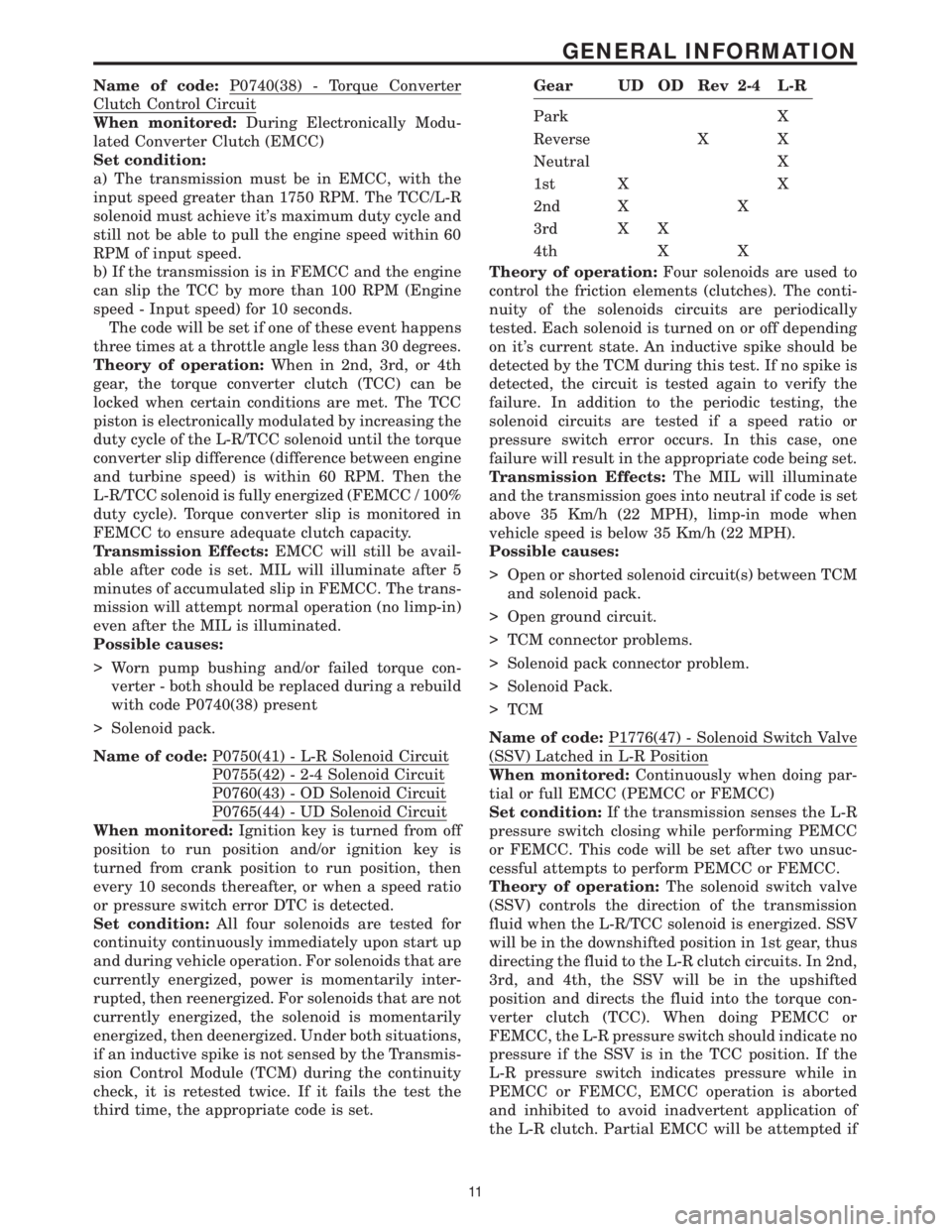
Name of code:P0740(38) - Torque Converter
Clutch Control Circuit
When monitored:During Electronically Modu-
lated Converter Clutch (EMCC)
Set condition:
a) The transmission must be in EMCC, with the
input speed greater than 1750 RPM. The TCC/L-R
solenoid must achieve it's maximum duty cycle and
still not be able to pull the engine speed within 60
RPM of input speed.
b) If the transmission is in FEMCC and the engine
can slip the TCC by more than 100 RPM (Engine
speed - Input speed) for 10 seconds.
The code will be set if one of these event happens
three times at a throttle angle less than 30 degrees.
Theory of operation:When in 2nd, 3rd, or 4th
gear, the torque converter clutch (TCC) can be
locked when certain conditions are met. The TCC
piston is electronically modulated by increasing the
duty cycle of the L-R/TCC solenoid until the torque
converter slip difference (difference between engine
and turbine speed) is within 60 RPM. Then the
L-R/TCC solenoid is fully energized (FEMCC / 100%
duty cycle). Torque converter slip is monitored in
FEMCC to ensure adequate clutch capacity.
Transmission Effects:EMCC will still be avail-
able after code is set. MIL will illuminate after 5
minutes of accumulated slip in FEMCC. The trans-
mission will attempt normal operation (no limp-in)
even after the MIL is illuminated.
Possible causes:
> Worn pump bushing and/or failed torque con-
verter - both should be replaced during a rebuild
with code P0740(38) present
> Solenoid pack.
Name of code:P0750(41) - L-R Solenoid Circuit
P0755(42) - 2-4 Solenoid Circuit
P0760(43) - OD Solenoid Circuit
P0765(44) - UD Solenoid Circuit
When monitored:Ignition key is turned from off
position to run position and/or ignition key is
turned from crank position to run position, then
every 10 seconds thereafter, or when a speed ratio
or pressure switch error DTC is detected.
Set condition:All four solenoids are tested for
continuity continuously immediately upon start up
and during vehicle operation. For solenoids that are
currently energized, power is momentarily inter-
rupted, then reenergized. For solenoids that are not
currently energized, the solenoid is momentarily
energized, then deenergized. Under both situations,
if an inductive spike is not sensed by the Transmis-
sion Control Module (TCM) during the continuity
check, it is retested twice. If it fails the test the
third time, the appropriate code is set.
Gear UD OD Rev 2-4 L-R
Park X
Reverse X X
Neutral X
1st X X
2nd X X
3rd X X
4th X X
Theory of operation:Four solenoids are used to
control the friction elements (clutches). The conti-
nuity of the solenoids circuits are periodically
tested. Each solenoid is turned on or off depending
on it's current state. An inductive spike should be
detected by the TCM during this test. If no spike is
detected, the circuit is tested again to verify the
failure. In addition to the periodic testing, the
solenoid circuits are tested if a speed ratio or
pressure switch error occurs. In this case, one
failure will result in the appropriate code being set.
Transmission Effects:The MIL will illuminate
and the transmission goes into neutral if code is set
above 35 Km/h (22 MPH), limp-in mode when
vehicle speed is below 35 Km/h (22 MPH).
Possible causes:
> Open or shorted solenoid circuit(s) between TCM
and solenoid pack.
> Open ground circuit.
> TCM connector problems.
> Solenoid pack connector problem.
> Solenoid Pack.
> TCM
Name of code:P1776(47) - Solenoid Switch Valve
(SSV) Latched in L-R Position
When monitored:Continuously when doing par-
tial or full EMCC (PEMCC or FEMCC)
Set condition:If the transmission senses the L-R
pressure switch closing while performing PEMCC
or FEMCC. This code will be set after two unsuc-
cessful attempts to perform PEMCC or FEMCC.
Theory of operation:The solenoid switch valve
(SSV) controls the direction of the transmission
fluid when the L-R/TCC solenoid is energized. SSV
will be in the downshifted position in 1st gear, thus
directing the fluid to the L-R clutch circuits. In 2nd,
3rd, and 4th, the SSV will be in the upshifted
position and directs the fluid into the torque con-
verter clutch (TCC). When doing PEMCC or
FEMCC, the L-R pressure switch should indicate no
pressure if the SSV is in the TCC position. If the
L-R pressure switch indicates pressure while in
PEMCC or FEMCC, EMCC operation is aborted
and inhibited to avoid inadvertent application of
the L-R clutch. Partial EMCC will be attempted if
11
GENERAL INFORMATION
Page 4128 of 4284
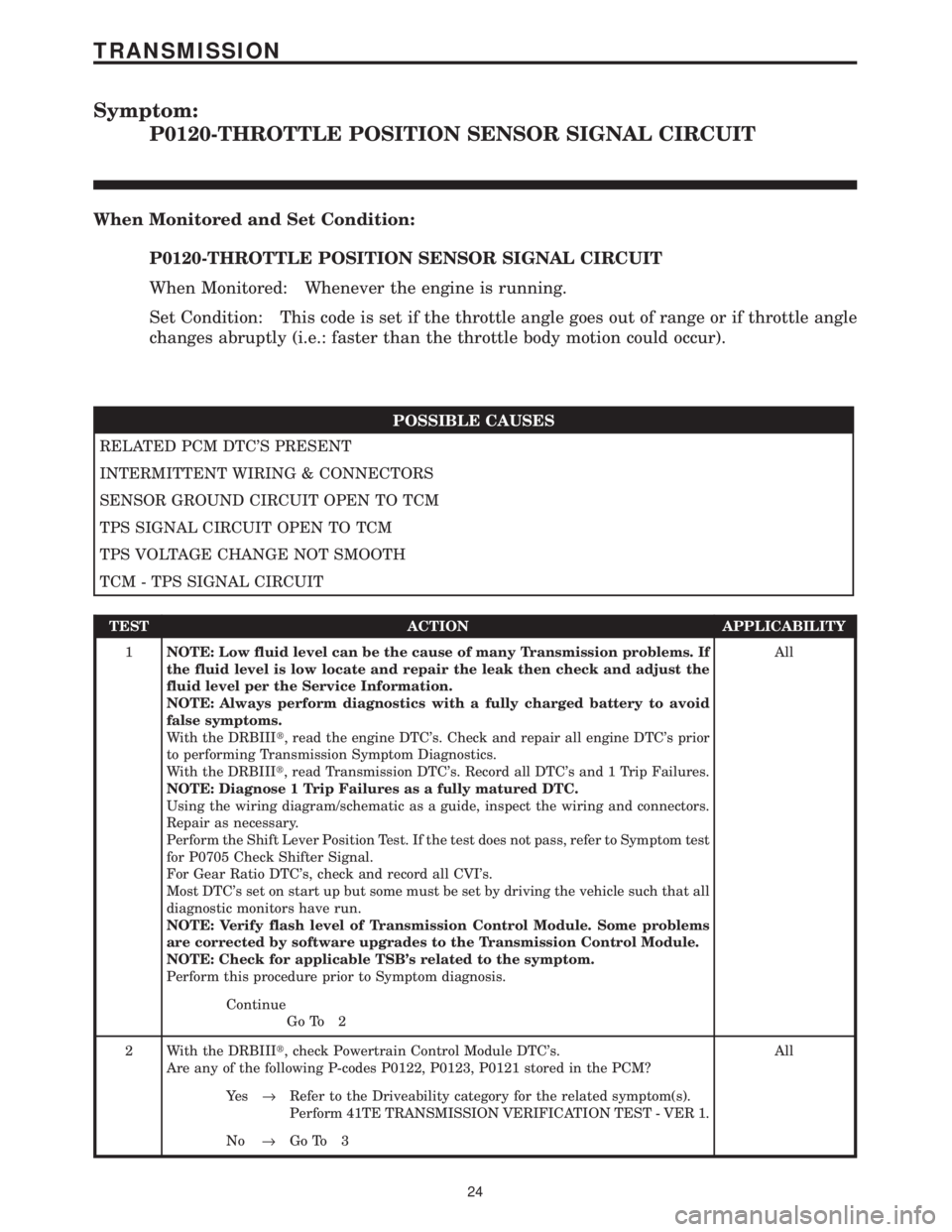
Symptom:
P0120-THROTTLE POSITION SENSOR SIGNAL CIRCUIT
When Monitored and Set Condition:
P0120-THROTTLE POSITION SENSOR SIGNAL CIRCUIT
When Monitored: Whenever the engine is running.
Set Condition: This code is set if the throttle angle goes out of range or if throttle angle
changes abruptly (i.e.: faster than the throttle body motion could occur).
POSSIBLE CAUSES
RELATED PCM DTC'S PRESENT
INTERMITTENT WIRING & CONNECTORS
SENSOR GROUND CIRCUIT OPEN TO TCM
TPS SIGNAL CIRCUIT OPEN TO TCM
TPS VOLTAGE CHANGE NOT SMOOTH
TCM - TPS SIGNAL CIRCUIT
TEST ACTION APPLICABILITY
1NOTE: Low fluid level can be the cause of many Transmission problems. If
the fluid level is low locate and repair the leak then check and adjust the
fluid level per the Service Information.
NOTE: Always perform diagnostics with a fully charged battery to avoid
false symptoms.
With the DRBIIIt, read the engine DTC's. Check and repair all engine DTC's prior
to performing Transmission Symptom Diagnostics.
With the DRBIIIt, read Transmission DTC's. Record all DTC's and 1 Trip Failures.
NOTE: Diagnose 1 Trip Failures as a fully matured DTC.
Using the wiring diagram/schematic as a guide, inspect the wiring and connectors.
Repair as necessary.
Perform the Shift Lever Position Test. If the test does not pass, refer to Symptom test
for P0705 Check Shifter Signal.
For Gear Ratio DTC's, check and record all CVI's.
Most DTC's set on start up but some must be set by driving the vehicle such that all
diagnostic monitors have run.
NOTE: Verify flash level of Transmission Control Module. Some problems
are corrected by software upgrades to the Transmission Control Module.
NOTE: Check for applicable TSB's related to the symptom.
Perform this procedure prior to Symptom diagnosis.All
Continue
Go To 2
2 With the DRBIIIt, check Powertrain Control Module DTC's.
Are any of the following P-codes P0122, P0123, P0121 stored in the PCM?All
Ye s®Refer to the Driveability category for the related symptom(s).
Perform 41TE TRANSMISSION VERIFICATION TEST - VER 1.
No®Go To 3
24
TRANSMISSION
Page 4136 of 4284
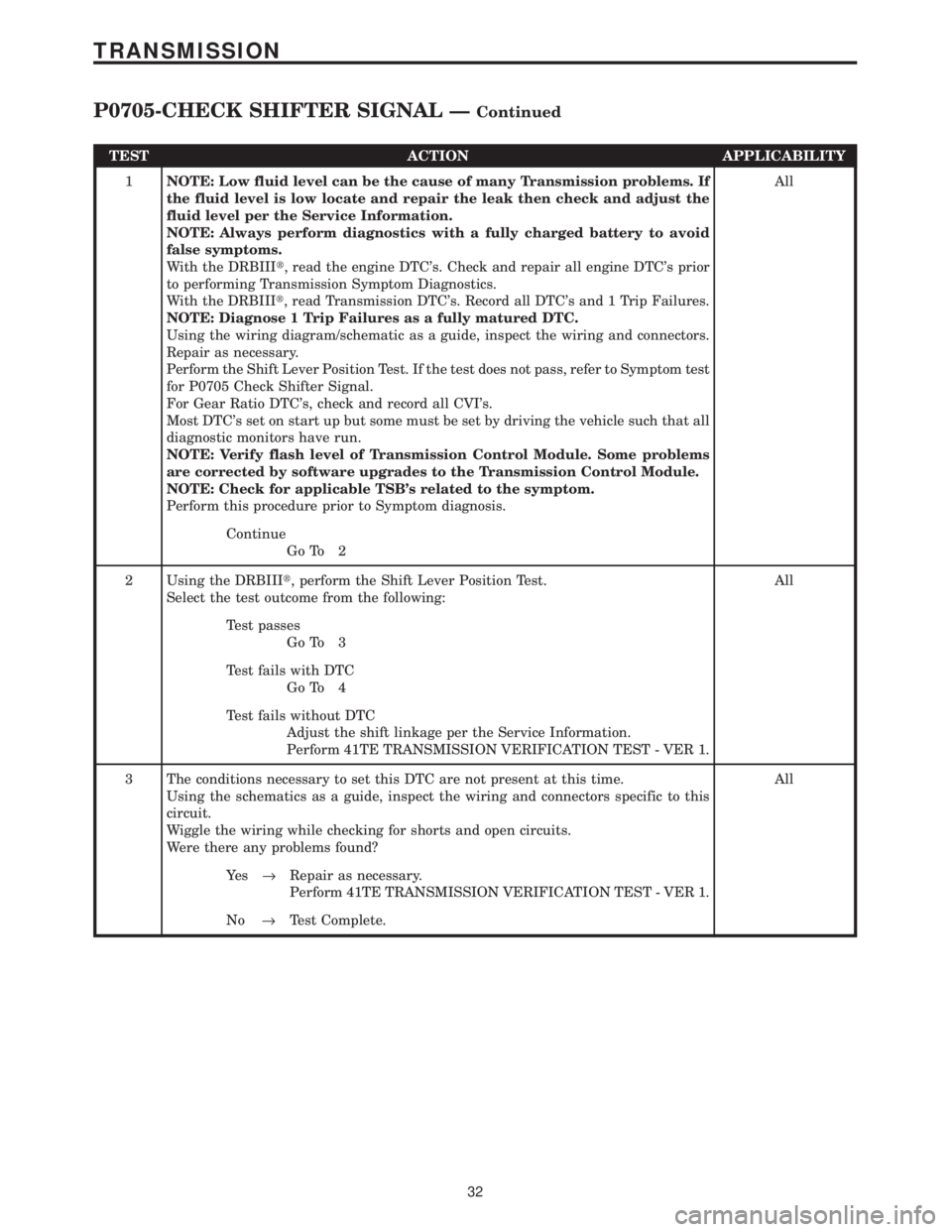
TEST ACTION APPLICABILITY
1NOTE: Low fluid level can be the cause of many Transmission problems. If
the fluid level is low locate and repair the leak then check and adjust the
fluid level per the Service Information.
NOTE: Always perform diagnostics with a fully charged battery to avoid
false symptoms.
With the DRBIIIt, read the engine DTC's. Check and repair all engine DTC's prior
to performing Transmission Symptom Diagnostics.
With the DRBIIIt, read Transmission DTC's. Record all DTC's and 1 Trip Failures.
NOTE: Diagnose 1 Trip Failures as a fully matured DTC.
Using the wiring diagram/schematic as a guide, inspect the wiring and connectors.
Repair as necessary.
Perform the Shift Lever Position Test. If the test does not pass, refer to Symptom test
for P0705 Check Shifter Signal.
For Gear Ratio DTC's, check and record all CVI's.
Most DTC's set on start up but some must be set by driving the vehicle such that all
diagnostic monitors have run.
NOTE: Verify flash level of Transmission Control Module. Some problems
are corrected by software upgrades to the Transmission Control Module.
NOTE: Check for applicable TSB's related to the symptom.
Perform this procedure prior to Symptom diagnosis.All
Continue
Go To 2
2 Using the DRBIIIt, perform the Shift Lever Position Test.
Select the test outcome from the following:All
Test passes
Go To 3
Test fails with DTC
Go To 4
Test fails without DTC
Adjust the shift linkage per the Service Information.
Perform 41TE TRANSMISSION VERIFICATION TEST - VER 1.
3 The conditions necessary to set this DTC are not present at this time.
Using the schematics as a guide, inspect the wiring and connectors specific to this
circuit.
Wiggle the wiring while checking for shorts and open circuits.
Were there any problems found?All
Ye s®Repair as necessary.
Perform 41TE TRANSMISSION VERIFICATION TEST - VER 1.
No®Test Complete.
32
TRANSMISSION
P0705-CHECK SHIFTER SIGNAL ÐContinued
Page 4142 of 4284
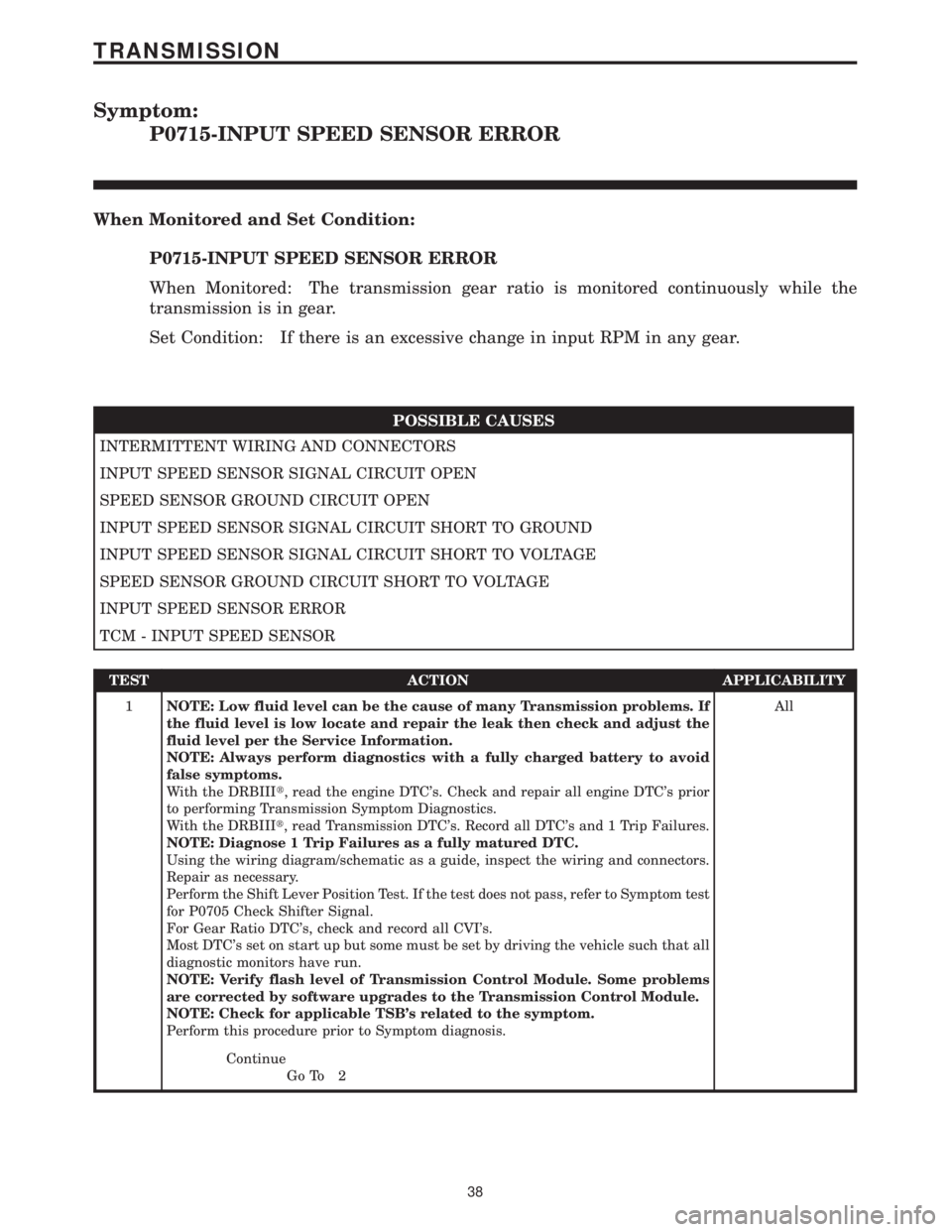
Symptom:
P0715-INPUT SPEED SENSOR ERROR
When Monitored and Set Condition:
P0715-INPUT SPEED SENSOR ERROR
When Monitored: The transmission gear ratio is monitored continuously while the
transmission is in gear.
Set Condition: If there is an excessive change in input RPM in any gear.
POSSIBLE CAUSES
INTERMITTENT WIRING AND CONNECTORS
INPUT SPEED SENSOR SIGNAL CIRCUIT OPEN
SPEED SENSOR GROUND CIRCUIT OPEN
INPUT SPEED SENSOR SIGNAL CIRCUIT SHORT TO GROUND
INPUT SPEED SENSOR SIGNAL CIRCUIT SHORT TO VOLTAGE
SPEED SENSOR GROUND CIRCUIT SHORT TO VOLTAGE
INPUT SPEED SENSOR ERROR
TCM - INPUT SPEED SENSOR
TEST ACTION APPLICABILITY
1NOTE: Low fluid level can be the cause of many Transmission problems. If
the fluid level is low locate and repair the leak then check and adjust the
fluid level per the Service Information.
NOTE: Always perform diagnostics with a fully charged battery to avoid
false symptoms.
With the DRBIIIt, read the engine DTC's. Check and repair all engine DTC's prior
to performing Transmission Symptom Diagnostics.
With the DRBIIIt, read Transmission DTC's. Record all DTC's and 1 Trip Failures.
NOTE: Diagnose 1 Trip Failures as a fully matured DTC.
Using the wiring diagram/schematic as a guide, inspect the wiring and connectors.
Repair as necessary.
Perform the Shift Lever Position Test. If the test does not pass, refer to Symptom test
for P0705 Check Shifter Signal.
For Gear Ratio DTC's, check and record all CVI's.
Most DTC's set on start up but some must be set by driving the vehicle such that all
diagnostic monitors have run.
NOTE: Verify flash level of Transmission Control Module. Some problems
are corrected by software upgrades to the Transmission Control Module.
NOTE: Check for applicable TSB's related to the symptom.
Perform this procedure prior to Symptom diagnosis.All
Continue
Go To 2
38
TRANSMISSION
Page 4146 of 4284
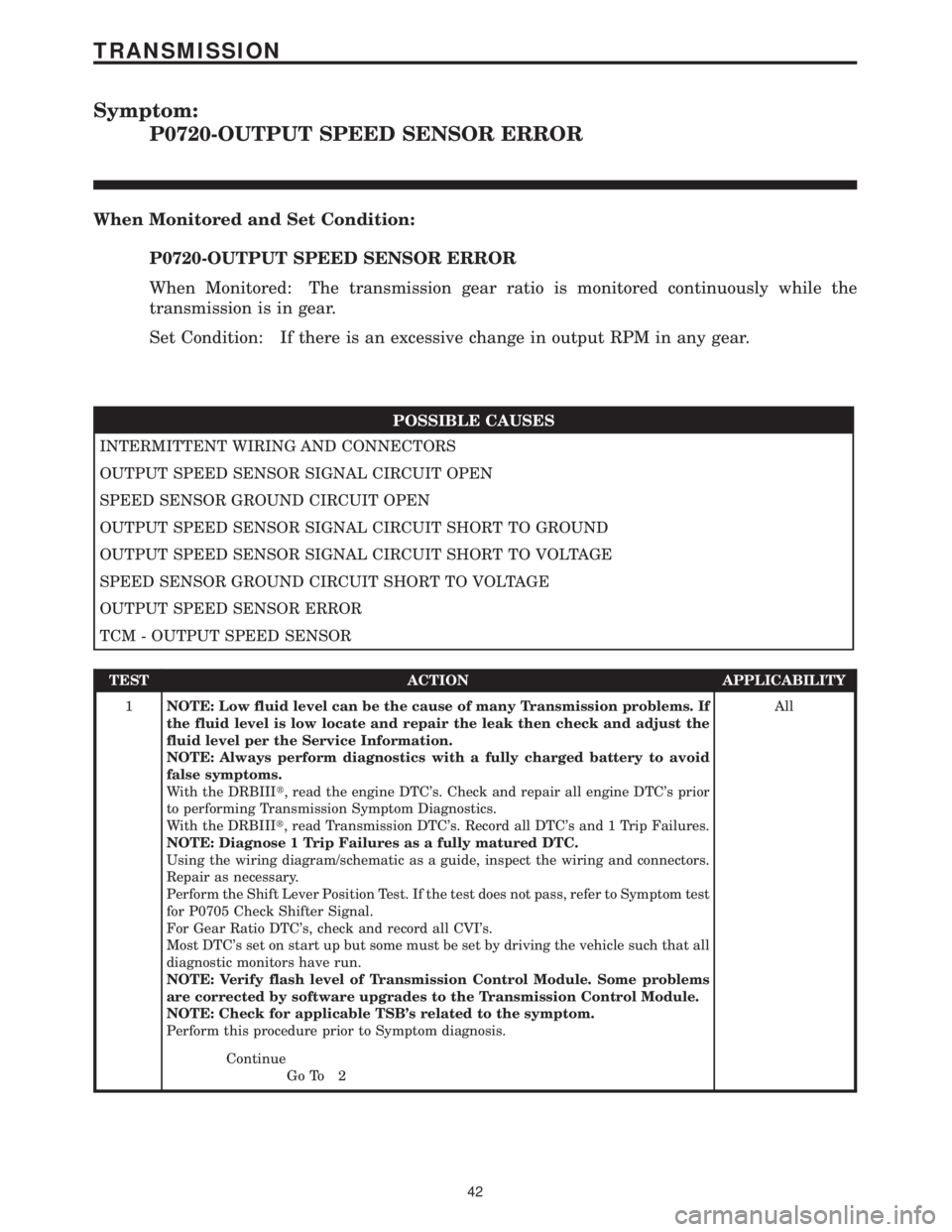
Symptom:
P0720-OUTPUT SPEED SENSOR ERROR
When Monitored and Set Condition:
P0720-OUTPUT SPEED SENSOR ERROR
When Monitored: The transmission gear ratio is monitored continuously while the
transmission is in gear.
Set Condition: If there is an excessive change in output RPM in any gear.
POSSIBLE CAUSES
INTERMITTENT WIRING AND CONNECTORS
OUTPUT SPEED SENSOR SIGNAL CIRCUIT OPEN
SPEED SENSOR GROUND CIRCUIT OPEN
OUTPUT SPEED SENSOR SIGNAL CIRCUIT SHORT TO GROUND
OUTPUT SPEED SENSOR SIGNAL CIRCUIT SHORT TO VOLTAGE
SPEED SENSOR GROUND CIRCUIT SHORT TO VOLTAGE
OUTPUT SPEED SENSOR ERROR
TCM - OUTPUT SPEED SENSOR
TEST ACTION APPLICABILITY
1NOTE: Low fluid level can be the cause of many Transmission problems. If
the fluid level is low locate and repair the leak then check and adjust the
fluid level per the Service Information.
NOTE: Always perform diagnostics with a fully charged battery to avoid
false symptoms.
With the DRBIIIt, read the engine DTC's. Check and repair all engine DTC's prior
to performing Transmission Symptom Diagnostics.
With the DRBIIIt, read Transmission DTC's. Record all DTC's and 1 Trip Failures.
NOTE: Diagnose 1 Trip Failures as a fully matured DTC.
Using the wiring diagram/schematic as a guide, inspect the wiring and connectors.
Repair as necessary.
Perform the Shift Lever Position Test. If the test does not pass, refer to Symptom test
for P0705 Check Shifter Signal.
For Gear Ratio DTC's, check and record all CVI's.
Most DTC's set on start up but some must be set by driving the vehicle such that all
diagnostic monitors have run.
NOTE: Verify flash level of Transmission Control Module. Some problems
are corrected by software upgrades to the Transmission Control Module.
NOTE: Check for applicable TSB's related to the symptom.
Perform this procedure prior to Symptom diagnosis.All
Continue
Go To 2
42
TRANSMISSION
Page 4150 of 4284

Symptom:
P0725-ENGINE SPEED SENSOR CIRCUIT (3.3L/3.8L)
When Monitored and Set Condition:
P0725-ENGINE SPEED SENSOR CIRCUIT (3.3L/3.8L)
When Monitored: Whenever the engine is running.
Set Condition: Engine RPM less than 390 or greater than 8000 for more than 2 seconds
while the engine is running.
POSSIBLE CAUSES
PCM TPS DTC'S PRESENT
INTERMITTENT WIRING & CONNECTORS
CRANK POSITION SENSOR GROUND CIRCUIT OPEN
CRANK POSITION SENSOR SIGNAL CIRCUIT OPEN
TCM - ENGINE SPEED SENSOR CIRCUIT
TEST ACTION APPLICABILITY
1NOTE: Low fluid level can be the cause of many Transmission problems. If
the fluid level is low locate and repair the leak then check and adjust the
fluid level per the Service Information.
NOTE: Always perform diagnostics with a fully charged battery to avoid
false symptoms.
With the DRBIIIt, read the engine DTC's. Check and repair all engine DTC's prior
to performing Transmission Symptom Diagnostics.
With the DRBIIIt, read Transmission DTC's. Record all DTC's and 1 Trip Failures.
NOTE: Diagnose 1 Trip Failures as a fully matured DTC.
Using the wiring diagram/schematic as a guide, inspect the wiring and connectors.
Repair as necessary.
Perform the Shift Lever Position Test. If the test does not pass, refer to Symptom test
for P0705 Check Shifter Signal.
For Gear Ratio DTC's, check and record all CVI's.
Most DTC's set on start up but some must be set by driving the vehicle such that all
diagnostic monitors have run.
NOTE: Verify flash level of Transmission Control Module. Some problems
are corrected by software upgrades to the Transmission Control Module.
NOTE: Check for applicable TSB's related to the symptom.
Perform this procedure prior to Symptom diagnosis.All
Continue
Go To 2
2 With the DRBIIIt, read PCM DTCs.
Are there any PCM Throttle Position Sensor DTC's present?All
Ye s®Repair all PCM Throttle Position Sensor DTCs before proceeding.
Refer to the driveability category for the appropriate symptom.
No®Go To 3
46
TRANSMISSION